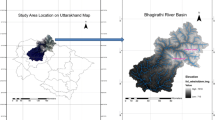Abstract
This study presented the application of partial least squares regression (PLSR) in estimating daily pan evaporation by utilizing the unique feature of PLSR in eliminating collinearity issues in predictor variables. The climate variables and daily pan evaporation data measured at two weather stations located near Elephant Butte Reservoir, New Mexico, USA and a weather station located in Shanshan County, Xinjiang, China were used in the study. The nonlinear relationship between climate variables and daily pan evaporation was successfully modeled using PLSR approach by solving collinearity that exists in the climate variables. The modeling results were compared to artificial neural networks (ANN) models with the same input variables. The results showed that the nonlinear equations developed using PLSR has similar performance with complex ANN approach for the study sites. The modeling process was straightforward and the equations were simpler and more explicit than the ANN black-box models.
Similar content being viewed by others
References
Penman H L. Natural evaporation from open water, bare soil and grass. Proceedings, Royal Society of London, 1948, 193: 120–145
Kohler M A, Nordenson T J, Fox W E. Evaporation from Pans on Lakes. Weather Bureau Research Paper 38. Washington, DC: US Department of Commerce, 1955
Tan S B K, Shuy E B, Chua L H C. Modelling hourly and daily open-water evaporation rates in areas with an equatorial climate. Hydrol Process, 2007, 21(4): 486–499
Stephens J C, Stewart E H. A Comparison of Procedures for Computing Evaporation and Evapotranspiration. Publication 62, International Association of Scientific Hydrology. International Union of Geodynamics and Geophysics, Berkeley, CA. 1963. 123–133
Priestley C H B, Taylor R J. On the assessment of the surface heat flux and evaporation using large-scale parameters. Monthly Weather Rev, 1972, 100: 81–92
Linacre E T. A simple formula for estimating evaporation rates in various climates, using temperature data alone. Agric Met, 1977, 18(6): 409–424
Hanson C L. Prediction of Class A pan evaporation in southwest Idaho. J Irrig Drain Eng, 1989, ASCE 115(2): 166–171
Kovoor G M, Nandagiri L. Developing regression models for predicting pan evaporation from climatic data—A comparison of multiple least-squares, principal components, and partial leastsquares approaches. J Irrigd Drain Eng, 2007, 133(5): 444–454
Shirsath P B, Singh A K. A comparative study of daily pan evaporation estimation using ANN, regression and climate based models. Water Resour Manage, 2010, 24: 1571–1581
Li Y. Study on water surface evaporation forecasting based on single correlation coefficient. Groundwater, 2010, 32(2): 113–114
Sudheer K P, Gosain A K, Rangan D M, et al. Modelling evaporation using an artificial neural network algorithm. Hydrol Process, 2002, 16: 3189–3202
Bruton J M, McClendon R W, Hoogenboom G. Estimating daily pan evaporation with artificial neural networks. Trans ASAE, 2000, 43(2): 491–496
Keskin M E, Terzi O. Artificial neural network models of daily pan evaporation. J. Hydrol Eng, 2006, 11(1): 65–70
Jin L, Shen S H, Luo Y, et al. Study on ANN calculation of water surface evaporation. J Nanjing Institute of Meteorology, 1996, 19(3): 342–347
Keskin M E, Terzi O, Taylan D. Fuzzy logic model approaches to daily pan evaporation estimation in western Turkey. Hydrol Sci J, 2004, 49(6): 1001–1010
Terzi O, Keskin M E, Taylan E D. Estimating evaporation using ANFIS. J Irrig Drain Eng, 2006, 132(5): 503–507
Eslamian S, Gohari S A, Biabanaki M, et al. Estimation of monthly pan evaporation using artificial neural networks and support vector machines. J Appl Sci, 2008, 8(19): 3497–3502
American Society of Civil Engineers (ASCE). Artificial neural network in hydrology: hydrologic applications. J Hydrol Eng, 2000, 5: 124–137
Geladi P, Kowalski B. Partial least squares regression: A tutorial. Analytica Chimica Acta, 1986, 185: 1–17
Neter J, Wasserman W, Kutner M H. Applied Linear Regression Models. 2nd ed. Homewood, Illinois: Richard D. Irwin, Inc., 1989
Abdi H. Partial least squares regression. In: Lewis-Beck M, Bryman A, Futing T, eds. The Sage Encyclopedia of Social Sciences Research Methods. Thousand Oaks, CA: Sage, 2003. 1–7
Tootle G A, Singh A K, Piechota T C, et al. Long lead-time forecasting of U.S. streamflow using partial least squares regression. J Hydrol Eng, 2007, 12(5): 442–451
Wold H. Estimation of principal components and related models by iterative least squares. In: Krishnaiah P R, ed. Multivariate Analysis. New York: Academic Press, 1966. 391–420
Wold S. PLS for multivariate linear modeling. In: van de Waterbeemd H ed. QSAR: Chemometric Methods in Molecular Design, Methods and Principles in Medicinal Chemistry. Weinheim: Verlag-Chemie, 1994. 195–218
Kim T, Valdes J B. Nonlinear model for drought forecasting based on a conjunction of wavelet transforms and neural networks. J Hydrol Eng, 2003, 8(6): 319–328.
Coulibaly P, Anctil F, Bobée B. Daily reservoir inflow forecasting using artificial neural networks with stopped training approach. J Hydrol, 2000, 3(4): 244–257
Dibike Y B, Solomatine D P. River flow forecasting using artificial neural networks. J Phys Chem Earth, Part B: Hydrol, Oceans Atmos, 2001, 26(1): 1–8
McCuen R H, Rawls W J, Whaley B L. Comparative evaluation of statistical methods for water supply forecasting. Water Resour Bull, 1979, 15(4): 935–947
Garen D C. Improved techniques in regression-based streamflow volume forecasting. J Water Res PL-ASCE, 1992, 118(6): 654–670
McCuen R H. Statistical Methods for Engineers. Englewood Cliffs, N. J.: Prentice Hall, 1985
NeuroDimension, Inc. NeuroSolutions Getting Started Manual Version 5, 2009
Author information
Authors and Affiliations
Corresponding author
Rights and permissions
About this article
Cite this article
Abudu, S., Cui, C., King, J.P. et al. Modeling of daily pan evaporation using partial least squares regression. Sci. China Technol. Sci. 54, 163–174 (2011). https://doi.org/10.1007/s11431-010-4205-z
Received:
Accepted:
Published:
Issue Date:
DOI: https://doi.org/10.1007/s11431-010-4205-z




